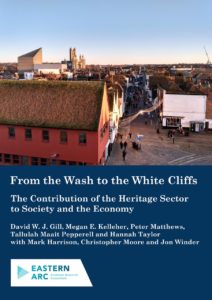New report highlights the contribution of heritage to the EARC region
10 August 2022
 A cross-disciplinary team from the universities of East Anglia, Essex and Kent has identified the significant challenges and opportunities for the heritage sector in the region.
A cross-disciplinary team from the universities of East Anglia, Essex and Kent has identified the significant challenges and opportunities for the heritage sector in the region.
The research, led by Professor David Gill and funded by the Eastern Arc consortium, was undertaken in collaboration with the Royal Society of Arts (RSA). It showed how heritage is increasingly under threat in the region, and what action needs to be taken to safeguard the significant historical assets across Kent, Essex, Suffolk and Norfolk.
Among the threats are the squeeze on local authority budgets and the cost of living crisis. Together, these have meant that there is less funding available from government or the public to support heritage at a time when it is increasingly under pressure from the climate emergency, the threat of heritage crime and a decreasing pool of volunteers to draw from.
‘This is an important and timely report,’ said Phil Ward, Director of Eastern Arc. ‘The east and southeast of England are home to some of our most important national heritage, from Canterbury Cathedral to Norwich Castle, from the Saxon Shore to Sutton Hoo. It helps us to understand our past and tell our national story. If we lose it then we lose an element of our identity. It must be protected.
‘This project is a crucial step towards doing this. It has helped to audit our assets and identify the significant challenges they face. But it also offers positive ways of ensuring their survival so that future generations will benefit from them. These include rebuilding audiences and embedding heritage in regional and national policy.’
‘Heritage contributes to the special character of our region,’ said Honorary Professor David Gill. ‘It contributes to the distinctive nature of our cities, towns, villages and landscapes.’
‘The value of our built and cultural heritage cannot be judged solely on a financial scale,’ said Mark Harrison, Head of Heritage Crime at Historic England, and Fellow in the Centre for Heritage, University of Kent.
‘The impact of loss and damage to historic buildings and archaeological sites, including those situated in the maritime environment, can have far-reaching consequences, and, in some instances, result in catastrophic and irreversible harm.
‘As our understanding of the threats and vulnerabilities posed to heritage sites, buildings and cultural property continues to improve, we will be better equipped to implement effective preventative measures; and, where offences are committed, to readily identify those responsible and to bring them to justice.’
‘Working on this project enabled me to learn more about the local histories on my doorstep, ‘ said Megan Kelleher, one of the researchers on the project. ‘I took for granted just how much history there was that I passed each day; through this project I’ve been able to identify more with the stories local to me and see how they impact our day to day lives.’
The report, published today and available here, will form the basis of a day-long conference that will bring together charities, community bodies, researchers, funders and policy-makers to identify the next positive steps in addressing the issues facing the heritage sector in the EARC region as well as nationally.
To find out more, contact David Gill or Phil Ward.
Gill, D. W. J., M. Kelleher, P. Matthews, T. M. Pepperell, H. Taylor, M. Harrison, C. Moore, and J. Winder. 2022. From the Wash to the White Cliffs: The Contribution of the Heritage Sector to Society and the Economy. Eastern Academic Research Consortium (EARC).
